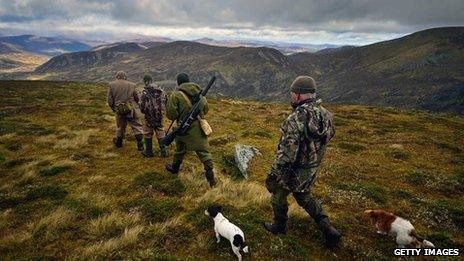Deer costs: The economics of Scotland's deer
- Published

Deer stalking is estimated to be worth £105m-a-year to the UK economy
There has been fresh debate over the culling of red deer in Scotland. One estate owner has said there were now too few mature stags, while Scottish Natural Heritage (SNH) has rejected suggestions of the animals' demise.
A recent SNH report assessed the economic benefits and costs of Scotland's red deer. Here are some of its headline figures:
Deer numbers
There are estimated to be between 360,000 and 400,000 red deer.
Also, 200,000 to 350,000 roe deer, 25,000 sika and as many as 2,000 fallow.
Economic worth
Deer stalking is thought to generate £105m-a-year for the UK economy with £70.4m of that money remaining in Scotland.
Clients of sporting estates can expect to pay up to £500 to shoot a stag and £100 for a hind.
It has also been estimated that a total of 2,520 jobs were associated with deer management.
Impact on forestry
According to the SNH report, studies have suggested that deer browsing on sitka spruce can affect how long it takes the trees to grow.
Trees damaged by deer can take about a year longer to grow in height than those that have not been browsed on.
Much longer delays have been recorded on other species, the report said.
It has also detailed how Forestry Commission Scotland manages about 1,630 acres (660,000 ha) of forestry and that in 2009/10 the cost of forest protection in Scotland, which mostly involved efforts to control deer, ran to £10.5m.
Road accidents
It has been estimated that in Europe as a whole between 500,000 and one million traffic accidents involving deer happen each year.
Within the UK, between 42,500 and 74,000 deer-related collisions occur every year resulting in about £17m of material damage. Up to 700 of these accidents involve injuries to drivers or passengers.
For Scotland, SNH has assessed that the total cost of material damage and human injury to be £9.4m.
Urban shift
Deer are increasingly becoming established within urban areas in the UK, according to the report.
One of the reasons for this has been the spread of villages, towns and cities into historic and current deer range.
However, roe deer have become well established in the centres of cities such as Glasgow and Edinburgh, raising the risk of collisions with traffic and damage to gardens and cemeteries.
The report suggested that the physical condition of deer in urban areas was poorer than that of animals living in more natural habitats.
Urban deer were also at a greater risk of dog attacks and their young being removed from mothers after people wrongly believing they have been orphaned.
The cost to the Scottish SPCA to go to the aid of deer injured in dog attacks or taken away from their mothers has been estimated to be £12,000-a-year.
- Published1 January 2013
- Published30 October 2012
- Published24 October 2012
- Published2 March 2012
- Published25 August 2011